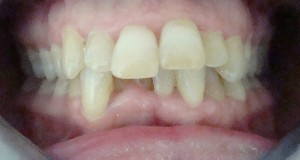Frequency And Characteristics Of Malocclusion In Adult Patients
 The aim of the current research was to study the frequency of the most usual malocclusion in adult Bulgarian non-growing orthodontics patients, referred for orthodontic treatment, as well as the correlation between examined malocclusions. 405 patients were included in this study. They were divided into two groups depending on age (21{44 and over 45 years of age). Each patient passed orthodontic check-up in an orthodontic clinic. Dental mirror, periodontal probe, caliper and articulation paper were used for diagnostics of the existing malocclusions. Angle’s classi_cation was applied for determining the dental class. The most common malocclusion were registered. The data was introduced and processed with statistical package SPSS 13.0.1. A descrip- tive analysis and accurate test of Fisher were applied. It was established that 69% of the patients have crowding, 51.0% have deep overbite, and 3.0% have open bite. The dental class was distributed as follows: 57.52% Class I Angle, 34.35% Class II Angle (uni- or bilaterally), and 7.91% Class III Angle (uni or bilaterally). The gender distribution was in correlation only with crowding.
The aim of the current research was to study the frequency of the most usual malocclusion in adult Bulgarian non-growing orthodontics patients, referred for orthodontic treatment, as well as the correlation between examined malocclusions. 405 patients were included in this study. They were divided into two groups depending on age (21{44 and over 45 years of age). Each patient passed orthodontic check-up in an orthodontic clinic. Dental mirror, periodontal probe, caliper and articulation paper were used for diagnostics of the existing malocclusions. Angle’s classi_cation was applied for determining the dental class. The most common malocclusion were registered. The data was introduced and processed with statistical package SPSS 13.0.1. A descrip- tive analysis and accurate test of Fisher were applied. It was established that 69% of the patients have crowding, 51.0% have deep overbite, and 3.0% have open bite. The dental class was distributed as follows: 57.52% Class I Angle, 34.35% Class II Angle (uni- or bilaterally), and 7.91% Class III Angle (uni or bilaterally). The gender distribution was in correlation only with crowding.
The age correlated with crowding, inclination of single/group of teeth, abrasion
and diastema. The presence of deep overbite showed correlation with abrasion, uni- or bilateral dental Class II. The current study showed a relatively high frequency of malocclusion in adults. This suggests an early prevention of malocclusions with the aim of optimal functional, aesthetic and long-term results to be achieved.
Изтеглете пълната версия на публикацията:
Frequency And Characteristics Of Malocclusion In Adult Patients





